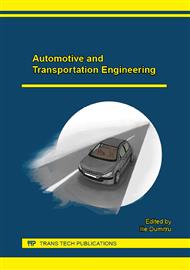[1]
I. Geonea, N. Dumitru, Design and motion analysis of a powered wheelchair, Applied Mechanics and Materials, Vol. 772 (2015), 613-620.
DOI: 10.4028/www.scientific.net/amm.772.613
Google Scholar
[2]
V. Kumar, Assistive Devices for People with Motor Disabilities, Wiley Encyclopedia of Electrical and Electronics Engineering, Assistive Devices for People with Motor Disabilities, (1997).
DOI: 10.1002/047134608x.w6603
Google Scholar
[3]
R.F. Edlich, K.P. Nelson, M.L. Foley, R.M. Buschbacher, W.B. Long and E.K. Ma, Technological advances in powered wheelchairs, J. Long. Term. Eff. Med. Implants, vol. 14, pp.107-130.
DOI: 10.1615/jlongtermeffmedimplants.v14.i2.40
Google Scholar
[4]
http: /www. wheelchairnet. org/WCN_WCU/Research/StakeholderDocs/PDFs/motors. pdf, accessed April (2014).
Google Scholar
[5]
http: /t2rerc. buffalo. edu/pubs/forums/mobility/forum/white_papers/motors. htm, accessed May, (2015).
Google Scholar
[6]
Modak G. S., Review Article: Evolution of a Stair-Climbing Power Wheelchair, IOSR Journal of Mechanical and Civil Engineering (IOSR-JMCE), pp.36-41, (2009).
Google Scholar
[7]
Reswick JB., Automatic transmission for electric wheelchairs, J. Rehabil. Res. Dev., (1985).
Google Scholar
[8]
http: /www. wheelchairnet. org/WCN_WCU/SlideLectures/DAH/AnatPoweredWCs-0699. pdf, accessed April (2014).
Google Scholar
[9]
https: /www. pololu. com/product/1390/specs, accessed April (2014).
Google Scholar
[10]
http: /www. instructables. com/id/Arduino-Modules-L298N-Dual-H-Bridge-Motor-Controll/, accessed April (2014).
Google Scholar
[11]
http: /www. mantech. co. za/datasheets/products/A000047. pdf, accessed April (2014).
Google Scholar
[12]
http: /www. digikey. com/product-highlights/us/en/arduino/1037, accessed April 2014.
Google Scholar
[13]
http: /paper. uscip. us/jvamc/jvamc. 2014. 1002. pdf, accessed April (2014).
Google Scholar
[14]
http: /www. wheelchairnet. org/WCN_WCU/Research/StakeholderDocs/PDFs/motors. pdf.
Google Scholar
[15]
https: /www. pololu. com/product/1390/specs.
Google Scholar
[16]
http: /paper. uscip. us/jvamc/jvamc. 2014. 1002. pdf.
Google Scholar
[17]
http: /www. instructables. com/id/Arduino-Modules-L298N-Dual-H-Bridge-Motor-Controll.
Google Scholar
[18]
http: /www. mantech. co. za/datasheets/products/A000047. pdf.
Google Scholar
[19]
http: /vbn. aau. dk/files/56232005/HSTreport_2011_1. pdf.
Google Scholar


